Solution Brief
Intelligent, Rapid Discovery of Video, Audio and Text Documents for Legal Teams
Discover More, Satisfy Production Requests and Minimize the Risk of e-Discovery Sanctions with Veritone aiWARE™

Today’s legal teams are often inundated with a tsunami of case information that must be reviewed and produced in litigation or other legal proceedings. Nearly 350,000 new cases are filed in U.S. courts alone each year. Many of these court cases involve voluminous amounts of data, including structured datasets such as spreadsheets, text documents or e-mails, and increasingly, unstructured data such as recorded phone calls, surveillance footage or other audio or video content. The volume and complexity of this data exacerbates an already arduous workload for legal professionals.
From e-mails to text messages to audio and video communications, the quantity and variety of Electronically Stored Information (ESI) used as evidence in legal proceedings keeps growing. Hidden within all this data are precious gems of insight that could determine the result of a court case. This is precisely where Veritone helps.
This brief describes how Veritone aiWARE™ provides legal professionals the ability to search and discover audio, video and text-based content in Relativity and other leading e-Discovery platforms to satisfy discovery requirements and uncover hidden gems of information that can help win cases. With aiWARE, law firms, corporate legal departments and government legal teams are able to cost effectively search, discover and produce unstructured and structured files in a secure, compliant way.
CHALLENGE
Efficiently and Cost Effectively Discovering Unstructured ESI
Viewing, searching and producing an audio or video file for legal proceedings used to require review of the media file outside of an e-Discovery platform. Without a transcript, these types of files are not searchable and require a manual, lengthy, and at times frustrating, review process. In particular, cases involving multilingual ESI prove to be especially challenging, often containing large amounts of ESI that need to be translated in order to pinpoint specific wording.
To meet discovery and production requirements, legal teams have often resorted to costly, manual efforts to review and assess audio and video evidence. These efforts frequently bog down document review teams by tying up resources unnecessarily. Furthermore, with the manual review of the audio and video files outside of the team’s e-Discovery solution, legal teams have not been able to take advantage of the same search capabilities and efficiencies offered by e-Discovery Solutions for text-based documents. Without the technology to systematically manage and automate the review of audio and video media in a cost-effective manner, parties to a lawsuit have often agreed to exclude such files from evidence, due to the significant cost and effort required to review and exchange such information. As technologies enabling the automated search and review of unstructured data on a cost-effective basi s have become more accepted, litigants are becoming less willing to exclude such evidence from the discovery process. As a result, legal teams need to be able to review and produce responsive unstructured data files to avoid sanctions for discovery violations. In addition, these technologies give legal teams an opportunity to gain more valuable evidence from their clients’ own unstructured data to support their cases.SOLUTION
Optimizing e-Discovery Processes with Veritone AI
Now, legal teams can leverage artificial intelligence (AI) to systematically turn unstructured data into structured data to make it easily searchable and more valuable to their cases.
Using AI, it is possible to process vast amounts of both structured and unstructured data within a legal team’s e-Discovery platform efficiently and cost effectively, allowing the team to focus on tasks that are more critical to the case. Veritone aiWARE makes all of this a reality.
HOW IT WORKS
Harnessing AI on Unstructured Media and Structured Files to Meet eDiscovery Needs
Veritone’s aiWARE solution extends eDiscovery capabilities beyond the boundaries of text documents. aiWARE allows legal teams to review in Relativity or through their custom workflows and to produce responsive unstructured data files, including audio and video files, much more efficiently than manual methods.
aiWARE FOR RELATIVITY & RELATIVITYONE
To meet e-Discovery requirements across the Electronic Discovery Reference Model (EDRM) , aiWARE enables and supports the following features within Relativity on-premise and RelativityOne in the cloud: translation, transcription, redaction and object recognition, while integrating with Relativity’s Structured and Conceptual Analytics.
Language Translation
When legal teams are managing multilingual case data for cross-border litigation , they need to be equipped to produce or discover foreign language files. With aiWARE, legal teams have a robust option to do so with the ability to translate any ESI file — including previously transcribed audio and video files — directly in Relativity.
aiWARE supports over 115 languages. In addition, Veritone has the ability to optimize the cognitive engines available through aiWARE to address industry-specific terms provided by a party to improve translation results, allowing legal teams to meet varying case requirements.
Veritone’s e-Discovery translation solution empowers legal teams to search for keywords and pinpoint the most relevant documents in their multilingual cases directly in Relativity. With aiWARE securely deployable on premise or in the cloud, legal teams can translate their foreign language ESI swiftly, efficiently and securely to meet discovery requirements.
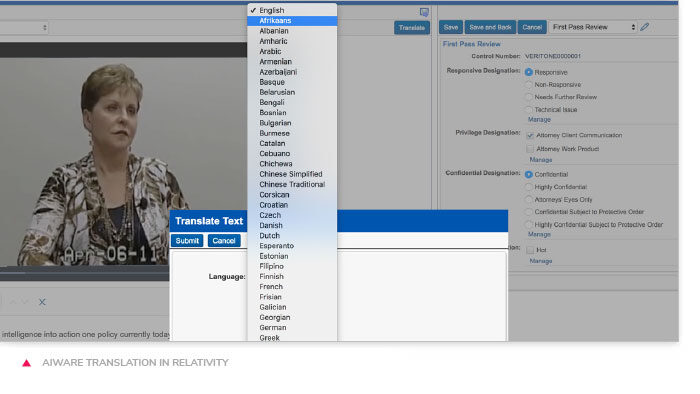
Machine Transcription
As the sheer volume of discovery information continues to grow, it is becoming increasingly impractical for legal teams to manually transcribe and review each discovery item.
With Veritone’s machine transcription solution, legal teams are empowered to transcribe audio and video files in over 60 languages and dialects in less time — in bulk or individually — directly in Relativity. Once transcribed, the files become searchable in Relativity along with other textbased documents. Legal teams can quickly and easily locate keywords and phrases within the transcript, and visually follow along as the transcript and video are played back in a synchronized manner for a closer review of the evidence.
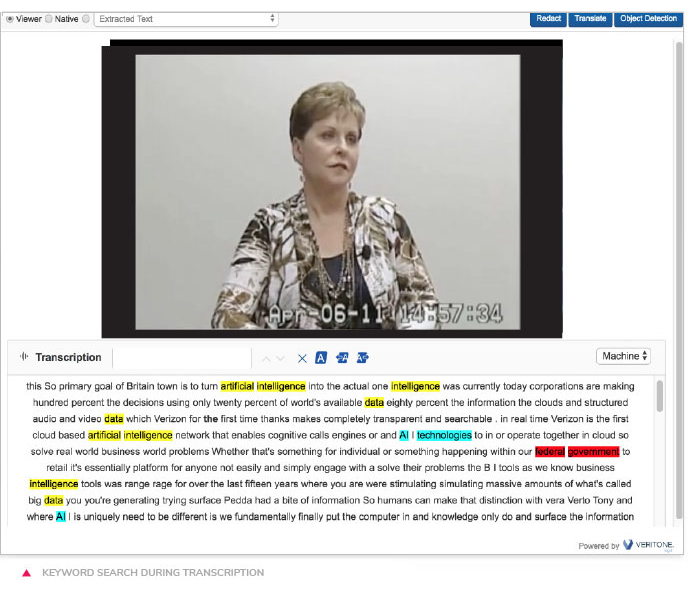
Audio and Video Redaction
Often, litigation teams must redact portions of evidence to remove privileged or personally identifiable information (PII) before the evidence can be produced. To date, this has been a tedious and time-consuming manual process. Veritone’s redaction solution in Relativity enables legal teams to easily redact selected portions of audio and video files and the associated transcript in Relativity, saving valuable time in the review process and streamlining review workflows. Redacted portions of transcripts are blacked out and the synchronized redacted audio and video segments are replaced with white noise and blurred images.
Legal teams are then able to identify and label their redacted files as desired for specific cases and mark which pieces of evidence are relevant or privileged. This allows legal teams to include their finalized redacted copies in productions to satisfy discovery requirements.
"...It was so simple to use, I even QC'd it because I QC everything, and it was perfect!"— Veritone Partner using Veritone’s redaction solution in Relativity for a legal matter
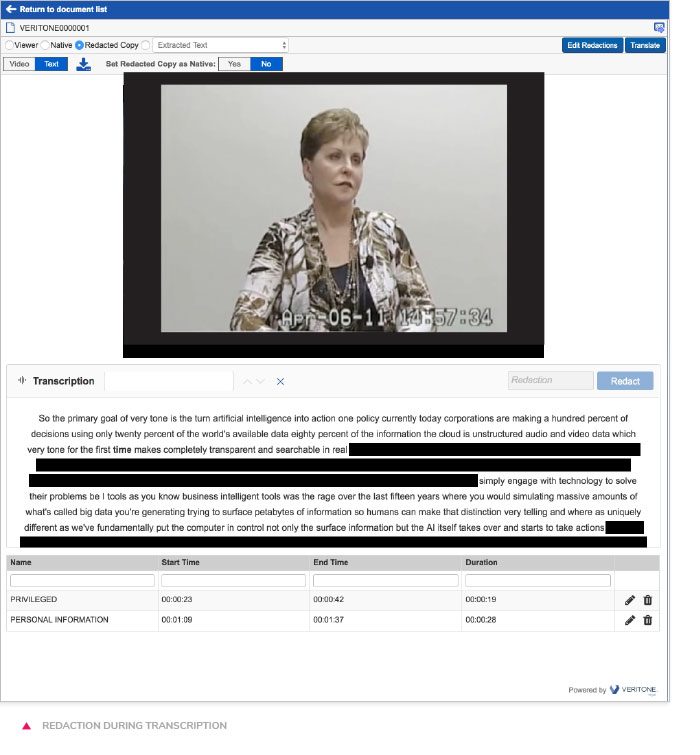
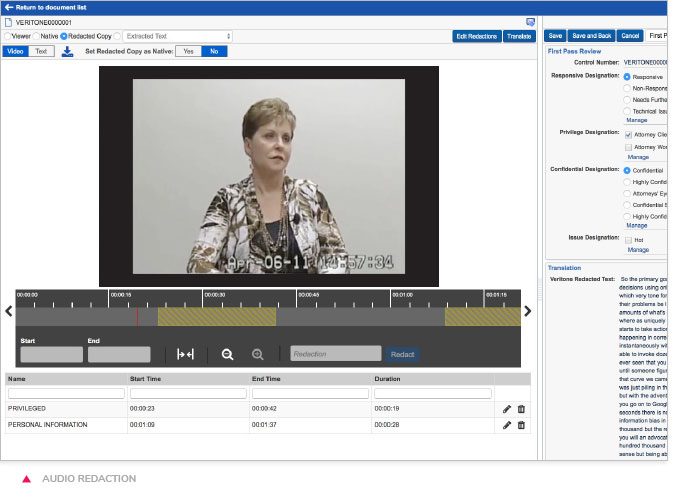
Object Recognition in Videos
Many times a case will hinge not on a written word but on what is seen in a video. Veritone’s object recognition solution in Relativity enables legal teams to recognize objects, logos and other imagery in their case videos, whether individually or in bulk.
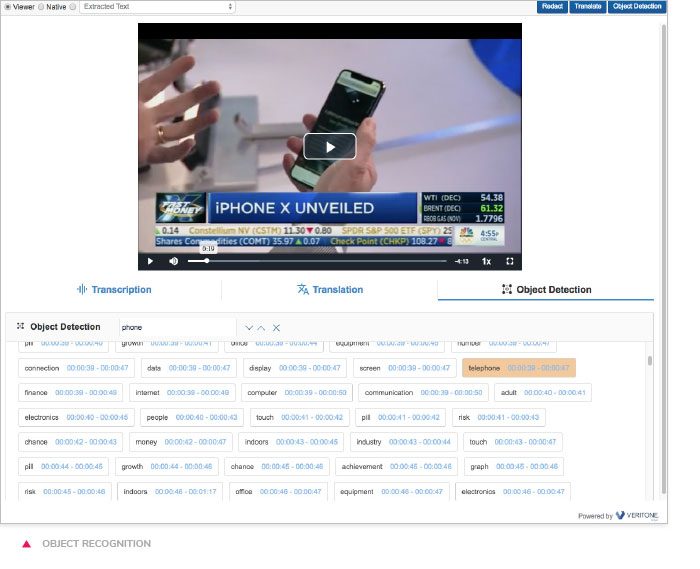
With aiWARE, legal teams are able to process video evidence through object detection engines, generating a summary of detected objects in their video evidence. The results are time-correlated and displayed below the video player. Users can then click on the object type in question to skip to the point in the video where the object appears, all while staying within Relativity. As a result, aiWARE allows legal teams to cull down and determine the relevance or privileged nature of recognized objects in video evidence for compliance with court requirements and discovery requests.
Conceptual and Structured Analytics
Many times a case will hinge not on a written word but For the aforementioned solutions, Veritone provides legal teams the ability to leverage their audio and video content in Relativity’s Structured and Conceptual Analytics to efficiently discover key content and uncover critical insights in their case evidence.
Language identification is also available for legal teams to track languages discovered on all media files as well as media file cluster visualization for clients to uncover in-depth insights on their media files, investigate key topics and detect discovery issues.
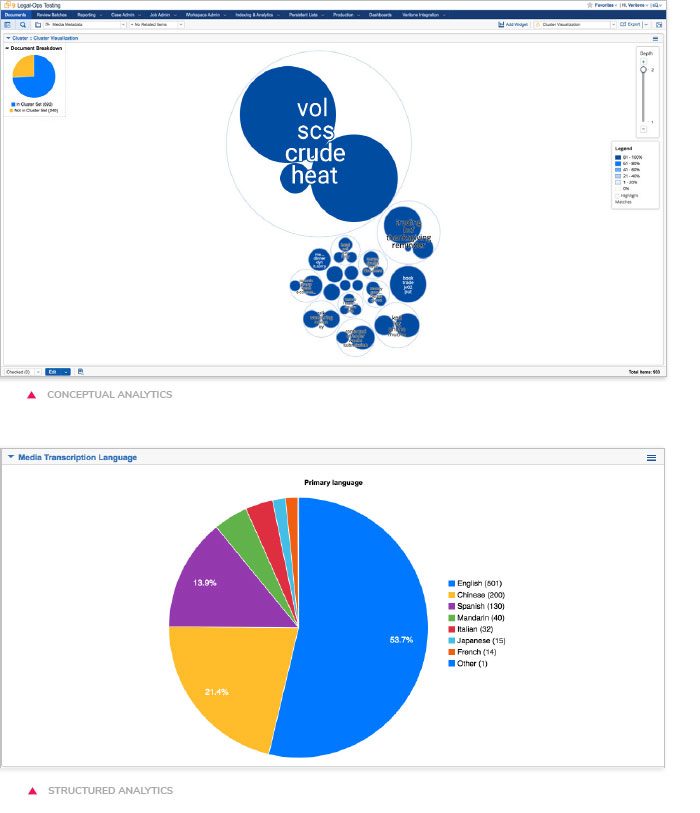
When you use aiWARE in Relativity or RelativityOne, you leverage multiple, best-of-breed AI engines working in concert to produce an index of enriched data within minutes — a process that previously could take thousands of hours — to meet e-Discovery requirements.
With aiWARE, the days of managing audio and video files outside of Relativity are over, and the ability to cost effectively manage and analyze large amounts of unstructured in conjunction with structured evidentiary media is now a reality.
Citations:
[i]Marr, Bernard. “How Big Data Is Disrupting Law Firms And The Legal Profession.” forbes.com. https://www.forbes.com/sites/bernardmarr/2016/01/20/how-big-data-is-disrupting-law-firms-and-the-legal-profession/#73d9f4607c23 (Accessed August 15, 2018).
[ii]The Electronic Discovery Reference Model (EDRM) is considered a pre-eminent conceptual view of the eDiscovery process and includes ESI evidentiary phases for: Information Governance, Identification, Preservation, Collection, Processing, Review, Analysis, Production and Preservation.